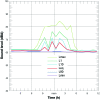Construction noise decreases reproductive efficiency in mice
- PMID: 19653943
- PMCID: PMC2715925
Construction noise decreases reproductive efficiency in mice
Abstract
Excessive noise is well known to impair rodent health. To better understand the effect of construction noise and to establish effective noise limits during a planned expansion of our vivarium, we analyzed the effects of construction noise on mouse gestation and neonatal growth. Our hypothesis was that high levels of construction noise would reduce the number of live births and retard neonatal growth. Female Swiss Webster mice were individually implanted with 15 B6CBAF1/J embryos and then exposed to 70- and 90-dBA concrete saw cutting noise samples at defined time points during gestation. In addition, groups of mice with litters were exposed to noise at 70, 80, or 90 dBA for 1 h daily during the first week after parturition. Litter size, birth weight, incidence of stillborn pups, and rate of neonatal weight gain were analyzed. Noise decreased reproductive efficiency by decreasing live birth rates and increasing the number of stillborn pups.
Figures








References
-
- Acoustical Society of America [Internet] Glossary of acoustical terms and definitions of terminology related to the science of acoustics. [Cited 2009 Jan 3]. Available from: http://www.webref.org/acoustics/acoustics.htm
-
- Baldwin AL, Bell IR. 2007. Effect of noise on microvascular integrity in laboratory rats. J Am Assoc Lab Anim Sci 46:58–65 - PubMed
-
- Baldwin AL, Primeau RL, Johnson WE. 2006. Effect of noise on the morphology of the intestinal mucosa in laboratory rats. J Am Assoc Lab Anim Sci 45:74–82 - PubMed
-
- Baldwin AL, Schwartz GE, Hopp DH. 2007. Are investigators aware of enviromental noise in animal facilities and that this noise may affect experimental data? J Am Assoc Lab Anim Sci 46:45–51 - PubMed
-
- Basak S, Dubanchet S, Zourbas S, Chaouat G, Das C. 2002. Expression of pro-inflammatory cytokines in mouse blastocyst during implantation: modulation by steroid hormones. Am J Reprod Immunol 47:2–11 - PubMed
MeSH terms
LinkOut - more resources
Full Text Sources
Other Literature Sources
